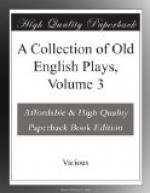‘According to my master Plato’s mind,’ &c.—iii. II.
And for the lower comedy, act iv., sc. 1, in which Momford makes Eugenia dictate a letter to Clarence, should be compared with the Gentleman Usher, iii. 1, and Monsieur d’Olive, iv. 1. These are clearly all from one mould.” I, like Mr. Fleay, had been struck by the resemblance to Chapman’s style in parts of Sir Gyles Goosecappe; but it seems to me that the likeness is stronger in the serious than in the comic scenes. If Chapman was the author, it is curious that his name did not appear on the title-page of the second edition. The reference to the Marechal de Biron’s visit, iii. 1, proves conclusively that the play cannot have been written earlier than the autumn of 1601.
INTRODUCTION TO DOCTOR DODYPOLL.
After reading the passages from “Dr. Dodypoll” in Lamb’s “Extracts from the Garrick Plays,” many students must have felt a desire to have the play in its entirety. I fear that in gratifying their desire I shall cause them some disappointment; and that, when they have read the play through, they will not care to remember much beyond what they knew already. “Dr. Dodypoll” affords a curious illustration of the astounding inequality in the work of the old dramatists. The opening scene, between Lucilia and Lord Lassenbergh, shows rich imagination and a worthy gift of expression. The writer, whoever he may have been, scatters his gold with a lavish hand. In the fine panegyric[47] on painting, there is a freedom of fancy that lifts us into the higher regions of poetry; and dull indeed must be the reader who can resist the contagion of Lassenbergh’s enthusiasm. But this strain of charming poetry is brought too quickly to a close, and then begins the comic business. Haunce, the serving-man, is just tolerable, but the French doctor, with his broken English, is a desperate bore. Soon the stage is crowded with figures, and we have to set our wits on work to follow the intricacies of the plot. Flores, the jeweller, has two daughters, Cornelia and Lucilia. The elder of the two, Cornelia, an ill-favoured virgin, whose affections are fixed on the young Lord Alberdure, has two contending suitors in the doctor and the merchant. Alberdure is in love with Hyanth, but he has a rival in the person of his own father, the Duke of Saxony, who had been previously contracted to the Lady Catherine. Meanwhile Lord Lassenbergh, who is living disguised as a painter under Flores’ roof, has gained the affections




